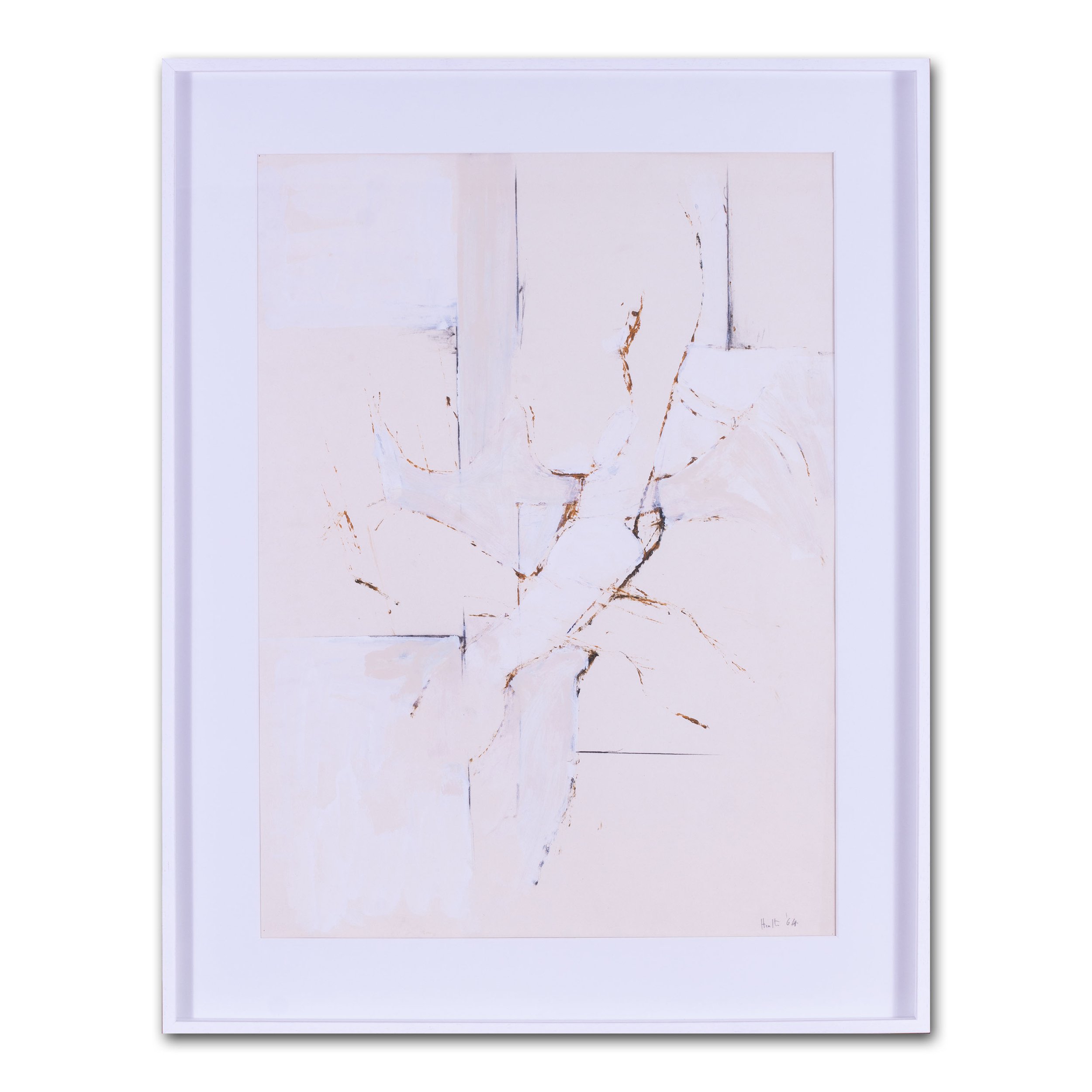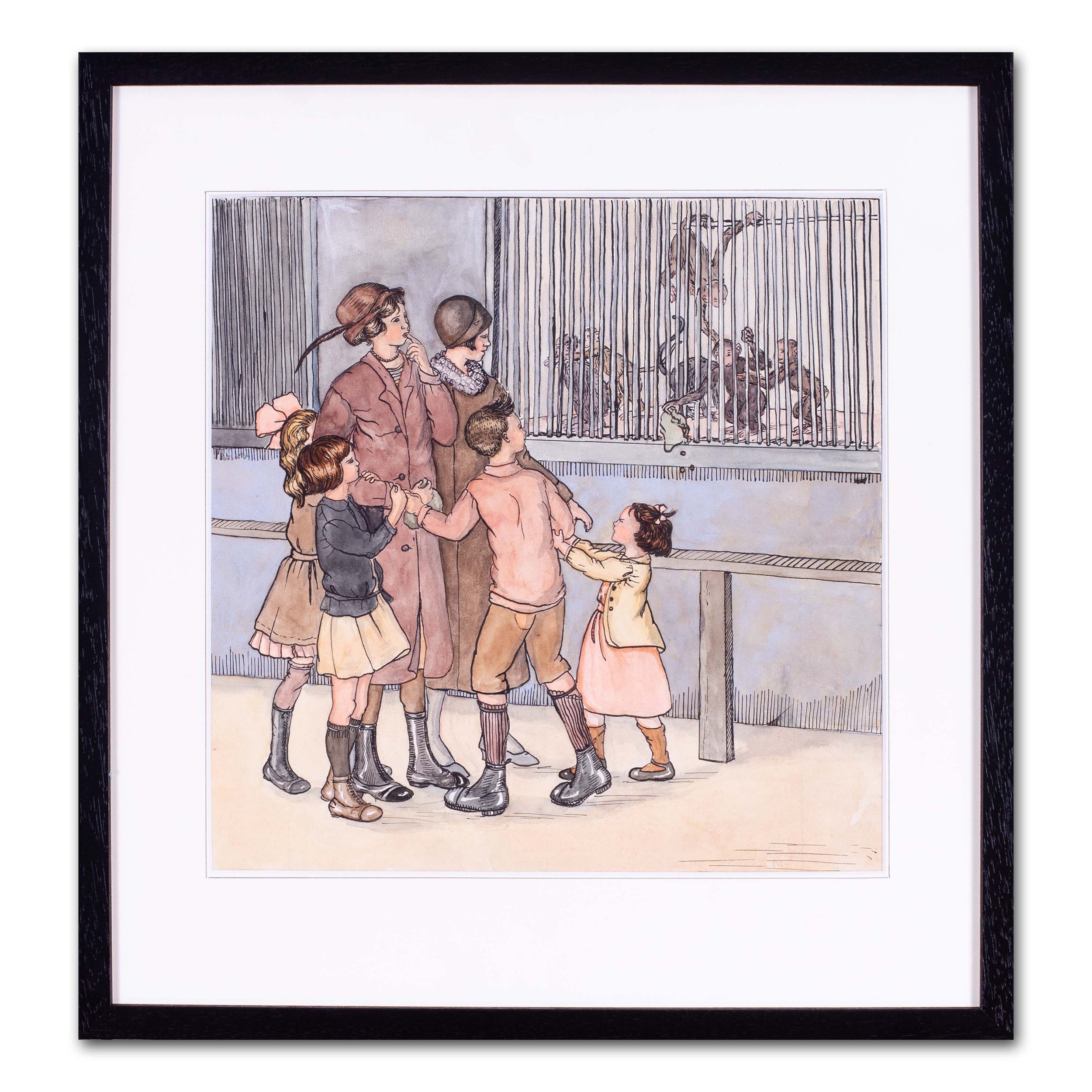Sidney Herbert Sime, 'An allegory of lost Time'
Sidney Herbert Sime, (British, 1867 – 1941)
An allegory of lost Time
Ink on paper
Signed ‘S. H. SIME.’ (lower right)
6.5/8 x 5.7/8 in. (17 x 14.5 cm.)
Condition: A few creases and fox marks. In a thick white mount, framed recently in black and silver.
Sidney Sime was born in Hulme, Manchester, to Scottish parents. Following the family’s move to Liverpool, his father found employment in a furniture warehouse. As his family was very poor, Sime was forced to spend five years of his childhood working in a Yorkshire colliery as a scoop pusher. He then took jobs assisting a linen draper, a baker, a barber and a shoemaker before taking up an apprenticeship as a sign writer and a framer. This involved time spent at Liverpool School of Art, between 1883-88, during the last year of which he won two prizes for drawing. This success helped him in his decision to become an illustrator.
By 1889, Sime had begun to publish and exhibit his work. Moving to London by 1893, he worked for numerous periodicals, notably Pick-Me-Up from 1895, The Idler from 1896, and the short-lived Eureka, which he edited in the years 1897-98. His early black-and-white magazine contributions, combining the comic and macabre, were influenced by both Aubrey Beardsley and Leonard Raven-Hill, and by such earlier illustrators as William Blake and Gustave Doré. He also exhibited paintings at the Royal Society of British Artists, following his membership in 1896.
In 1898, his uncle, a prosperous solicitor in Edinburgh, died and left Sime £14,000 and a small estate at Aberfoyle, Perthshire. This enabled him to marry Mary Susan Pickett, an Edinburgh miniature painter and illustrator, and buy The Idler. However, the latter venture failed, and he sold the goodwill in 1901 for £5. Then, in 1903, he bought the Old Crown Inn, Worplesdon, Surrey, and converted it into a cottage; following his removal from Scotland, he would live there for the remainder of his life.
In 1905-6, Sime spent six months in the USA, working for Randolph Hearst, who called him ‘the Greatest Living Imaginative Artist’ (quoted in Bryant 2000, page 207). On his return to England, he began to concentrate on book illustration, collaborating on ten books with the fantasy author, Edward Plunkett, Lord Dunsany – beginning with The Gods of Pegana (1905). He had an equally fruitful relationship with Thomas Scott-Ellis, Lord Howard de Walden, designing sets and costumes for the operatic version of his dramatic trilogy The Cauldron of Annwn, which, with music by Joseph Holbrooke, premiered from 1912. Holbrooke would also provide the tunes for Bogey Beasts (1923), Sime’s own book of songs.
In the last few months of the First World War, during 1918, Sime served in the Army Service Corps. As a result, he became obsessed with the vision of St John in the Book of Revelation, and produced his own images of the Apocalypse. More generally, he worked increasingly on small oils and watercolours, which showed the influence of Japanese prints. He was also Director of Art at the Yorick Club, which, according to his patron, Desmond Coke, was hung with his theatrical caricatures. Yet, cultivating a contempt for fame, he only occasionally showed his work, his solo shows at the St George’s Gallery in 1924 and 1927 proving rare showcases.
Dying of neglect on 21 May 1941, he has since been honoured by the foundation of the Sidney Sime Gallery at the Worplesdon Memorial Hall.
Sidney Herbert Sime, (British, 1867 – 1941)
An allegory of lost Time
Ink on paper
Signed ‘S. H. SIME.’ (lower right)
6.5/8 x 5.7/8 in. (17 x 14.5 cm.)
Condition: A few creases and fox marks. In a thick white mount, framed recently in black and silver.
Sidney Sime was born in Hulme, Manchester, to Scottish parents. Following the family’s move to Liverpool, his father found employment in a furniture warehouse. As his family was very poor, Sime was forced to spend five years of his childhood working in a Yorkshire colliery as a scoop pusher. He then took jobs assisting a linen draper, a baker, a barber and a shoemaker before taking up an apprenticeship as a sign writer and a framer. This involved time spent at Liverpool School of Art, between 1883-88, during the last year of which he won two prizes for drawing. This success helped him in his decision to become an illustrator.
By 1889, Sime had begun to publish and exhibit his work. Moving to London by 1893, he worked for numerous periodicals, notably Pick-Me-Up from 1895, The Idler from 1896, and the short-lived Eureka, which he edited in the years 1897-98. His early black-and-white magazine contributions, combining the comic and macabre, were influenced by both Aubrey Beardsley and Leonard Raven-Hill, and by such earlier illustrators as William Blake and Gustave Doré. He also exhibited paintings at the Royal Society of British Artists, following his membership in 1896.
In 1898, his uncle, a prosperous solicitor in Edinburgh, died and left Sime £14,000 and a small estate at Aberfoyle, Perthshire. This enabled him to marry Mary Susan Pickett, an Edinburgh miniature painter and illustrator, and buy The Idler. However, the latter venture failed, and he sold the goodwill in 1901 for £5. Then, in 1903, he bought the Old Crown Inn, Worplesdon, Surrey, and converted it into a cottage; following his removal from Scotland, he would live there for the remainder of his life.
In 1905-6, Sime spent six months in the USA, working for Randolph Hearst, who called him ‘the Greatest Living Imaginative Artist’ (quoted in Bryant 2000, page 207). On his return to England, he began to concentrate on book illustration, collaborating on ten books with the fantasy author, Edward Plunkett, Lord Dunsany – beginning with The Gods of Pegana (1905). He had an equally fruitful relationship with Thomas Scott-Ellis, Lord Howard de Walden, designing sets and costumes for the operatic version of his dramatic trilogy The Cauldron of Annwn, which, with music by Joseph Holbrooke, premiered from 1912. Holbrooke would also provide the tunes for Bogey Beasts (1923), Sime’s own book of songs.
In the last few months of the First World War, during 1918, Sime served in the Army Service Corps. As a result, he became obsessed with the vision of St John in the Book of Revelation, and produced his own images of the Apocalypse. More generally, he worked increasingly on small oils and watercolours, which showed the influence of Japanese prints. He was also Director of Art at the Yorick Club, which, according to his patron, Desmond Coke, was hung with his theatrical caricatures. Yet, cultivating a contempt for fame, he only occasionally showed his work, his solo shows at the St George’s Gallery in 1924 and 1927 proving rare showcases.
Dying of neglect on 21 May 1941, he has since been honoured by the foundation of the Sidney Sime Gallery at the Worplesdon Memorial Hall.
Sidney Herbert Sime, (British, 1867 – 1941)
An allegory of lost Time
Ink on paper
Signed ‘S. H. SIME.’ (lower right)
6.5/8 x 5.7/8 in. (17 x 14.5 cm.)
Condition: A few creases and fox marks. In a thick white mount, framed recently in black and silver.
Sidney Sime was born in Hulme, Manchester, to Scottish parents. Following the family’s move to Liverpool, his father found employment in a furniture warehouse. As his family was very poor, Sime was forced to spend five years of his childhood working in a Yorkshire colliery as a scoop pusher. He then took jobs assisting a linen draper, a baker, a barber and a shoemaker before taking up an apprenticeship as a sign writer and a framer. This involved time spent at Liverpool School of Art, between 1883-88, during the last year of which he won two prizes for drawing. This success helped him in his decision to become an illustrator.
By 1889, Sime had begun to publish and exhibit his work. Moving to London by 1893, he worked for numerous periodicals, notably Pick-Me-Up from 1895, The Idler from 1896, and the short-lived Eureka, which he edited in the years 1897-98. His early black-and-white magazine contributions, combining the comic and macabre, were influenced by both Aubrey Beardsley and Leonard Raven-Hill, and by such earlier illustrators as William Blake and Gustave Doré. He also exhibited paintings at the Royal Society of British Artists, following his membership in 1896.
In 1898, his uncle, a prosperous solicitor in Edinburgh, died and left Sime £14,000 and a small estate at Aberfoyle, Perthshire. This enabled him to marry Mary Susan Pickett, an Edinburgh miniature painter and illustrator, and buy The Idler. However, the latter venture failed, and he sold the goodwill in 1901 for £5. Then, in 1903, he bought the Old Crown Inn, Worplesdon, Surrey, and converted it into a cottage; following his removal from Scotland, he would live there for the remainder of his life.
In 1905-6, Sime spent six months in the USA, working for Randolph Hearst, who called him ‘the Greatest Living Imaginative Artist’ (quoted in Bryant 2000, page 207). On his return to England, he began to concentrate on book illustration, collaborating on ten books with the fantasy author, Edward Plunkett, Lord Dunsany – beginning with The Gods of Pegana (1905). He had an equally fruitful relationship with Thomas Scott-Ellis, Lord Howard de Walden, designing sets and costumes for the operatic version of his dramatic trilogy The Cauldron of Annwn, which, with music by Joseph Holbrooke, premiered from 1912. Holbrooke would also provide the tunes for Bogey Beasts (1923), Sime’s own book of songs.
In the last few months of the First World War, during 1918, Sime served in the Army Service Corps. As a result, he became obsessed with the vision of St John in the Book of Revelation, and produced his own images of the Apocalypse. More generally, he worked increasingly on small oils and watercolours, which showed the influence of Japanese prints. He was also Director of Art at the Yorick Club, which, according to his patron, Desmond Coke, was hung with his theatrical caricatures. Yet, cultivating a contempt for fame, he only occasionally showed his work, his solo shows at the St George’s Gallery in 1924 and 1927 proving rare showcases.
Dying of neglect on 21 May 1941, he has since been honoured by the foundation of the Sidney Sime Gallery at the Worplesdon Memorial Hall.

















